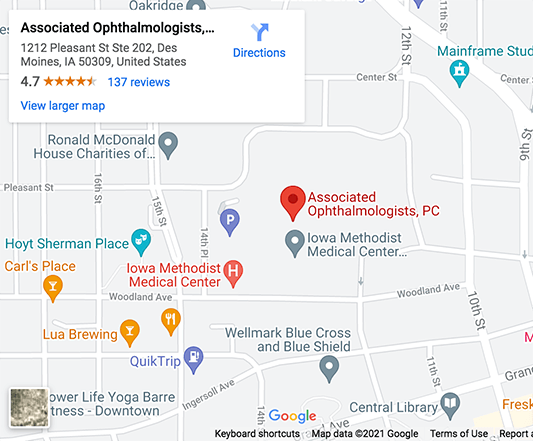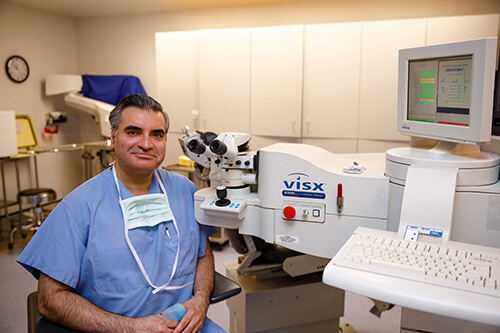
S. Ejaz Husain MD, FACS
Laser Treatment for Correcting Near-sightedness, Far-sightedness and Astigmatism
To Our Patients
Laser Vision Correction is an exciting alternative to contact lenses and glasses. Since 1995, tremendous progress has been made in the field of laser vision correction in treating refractive errors of the eye such as near-sightedness, far-sightedness and astigmatism. This technology has proven remarkably effective in reducing or eliminating dependence on glasses and contact lenses. The following information provides you with an overview of laser eye surgery in general. We use the most advanced VISX S4 excimer laser, equipped with Iris Registration, Active Trak, iDesign Wavefront technology, and Variable Spot Scanning. This is the very best technology available today. This is the only laser that uses the advanced 3-dimensional eye tracking system, developed specifically for tracking the human eye during laser vision correction.
Along with shorter treatment times, this laser removes less tissue than other lasers available and so preserves more corneal tissue. The VISX laser has been used by more ophthalmologists than any other laser in the United States and over 10 million people globally have been treated successfully with this laser.
We truly care for our patients and Dr. Husain personally examines every patient himself. Our belief is that laser vision correction is a surgery, and it is in the best interest of every patient to follow up with their surgeon both pre-operatively and post-operatively. We believe in a conservative approach and with this philosophy have enjoyed among the lowest complication and enhancement rates in the field. Being a part of an established and reputable practice in Des Moines, Dr. Husain’s patients like the easy access to their surgeon. Patients choose us primarily because of our excellent outcomes and quality of care.
To discuss these matters further, please call Dr. Husain’s Laser Vision Coordinator at (515) 244-EYES (3937) or e-mail us.
Our Philosophy:
When it comes to your eyes, there should be no compromise.
- It is important to understand that Laser vision correction is a surgery. As with all surgery, the results are dependent on the skills, experience, judgment and ethics of the surgeon. Please do not be misled by inaccurate, aggressive and overly sensational advertising that is commonly seen in the newspapers and the media. Since Lasik is economically driven, some practices tend to trivialize the procedure in order to gain market and patient share. Since all surgery has some risk associated with it, the critical thing the patient needs to understand is that an experienced surgeon is the most qualified individual to evaluate, perform surgery and do follow up care. Therefore, it is important for you to know who will be evaluating your eyes, and who will be providing follow-up care after your surgery. If an improper claim is made by someone that the surgeon will not need to see you after surgery, then this should raise a red flag and prompt appropriate questioning by the patient. A medical procedure on your eyes is not a product that should be commissioned. It is also important to understand that excellent results come from being very selective in choosing the right candidates and not by doing surgery on everybody who walks into the clinic. Not everyone is a candidate for refractive surgery.
- All technological devices used in Laser Vision Correction should be approved by the FDA. The FDA studies show that all these devices are equivalent in their efficacy, safety and predictability. It would be inappropriate for the FDA to approve lasers or devices that are unequal in their safety profile. Therefore be wary of claims in ads that try to attract patients with claims of superior technology and safety. Numerous studies have shown that it is in fact the surgeon’s experience, judgment and quality of care which drives the results. The technology is only as good as the surgeon utilizing it. If the surgeon is meticulous in managing the patients and is attentive to detail, the chances of a successful outcome are maximized. It is also better to use state of the art technology that has undergone rigorous and exhaustive testing over a long period of time in millions of patients (industry standard), rather than jumping on the bandwagon of a new technology that has just been approved and has not undergone extensive long-term follow-up. A conservative approach to surgery is very important. Although we all look forward to better technology for our patients, be wary of claims in ads that just seem to push technology. Similar claims were made over the last few years with other procedures, which, despite the great hype, have been discarded by most ophthalmologists.
- Make sure your surgeon is accessible to you when you need him or her. Non-medical personnel care is not equivalent to the care that the surgeon can provide. Your goal is to find a center that will provide the best surgery and state of the art equipment; and a surgeon who will provide an honest assessment about your likely outcomes and risks and personalized quality care after your surgery.
- Make sure your surgeon personally answers all your questions and concerns. The surgeon should also discuss other alternative procedures, their risks and benefits. A lot of places are becoming like factories, and patients are literally getting in and out of chairs. In our desire to promote the positive aspects of refractive surgery, one should not minimize the potential for complications nor forget that everyone is not a suitable candidate for existing technology.
- Careful and meticulous pre-operative evaluation by your surgeon is probably the most important factor leading to a successful outcome in Laser Vision Correction. Make sure your surgeon personally evaluates your eyes and does not rely entirely on non-medical personnel.
What is laser eye surgery?
Lasers are used to treat many eye conditions. Since 1995 one of the most exciting advances has been the development of lasers in treating refractive errors of the eye, that is, near-sightedness, far-sightedness and astigmatism. In fact, the laser we use to treat these eye-focusing problems is FDA approved for both LASIK and Advanced Surface Ablation (ASA), also known as flap-free laser vision correction.
What are refractive errors of the eye?
How Does The Eye See
The eye is like a camera that has two lenses. One of these lenses is the crystalline lens inside the eye. The other lens is the cornea, which is positioned in the eye like a watch crystal which actually provides 2/3 of the eye’s focusing power. When the light rays entering the eye are perfectly focused on the retina, the eye is neither nearsighted nor farsighted. This condition is called “emmetropia.”
Myopia, or near-sightedness, occurs when the eye has too much focusing power. As a result, objects at distance are blurry, whereas objects that are close can be clearly seen (unless astigmatism is present). Typically, the myopic eye is slightly longer or has a steeper cornea compared to the normal eye.
Hyperopia, or far-sightedness, occurs when the eye lacks sufficient focusing power. This usually causes objects at a distance to appear blurry, and near objects are seen even less clearly. Typically, the far-sighted eye is slightly shorter or has a flatter cornea than the normal eye.
Astigmatism is a condition in which light rays in different orientations are brought to different points of focus. A useful analogy is the comparison of a basketball to a football. The surface of a basketball has equal curvature in all directions, whereas a football is flatter in one orientation and steeper in the other. The surface of the football represents the situation that is present when the eye has astigmatism. Usually, the astigmatism occurs in the cornea. Astigmatism leads to blurred or distorted vision at all distances without correction. This can often be corrected with glasses or contact lenses, or in many instances, treated with refractive surgery.
Presbyopia is a natural condition that typically becomes noticeable around age 45. In children and young adults, the crystalline lens inside the eye can focus at a distant object and then easily increase its focusing power to look at a near object. As we get older, the lens inside the eye loses this capacity to focus in and out. When this occurs, individuals find that they need to hold reading material at greater distances. Ultimately, reading glasses are needed, typically by the mid-40s.
LASIK (laser in situ keratomileusis)
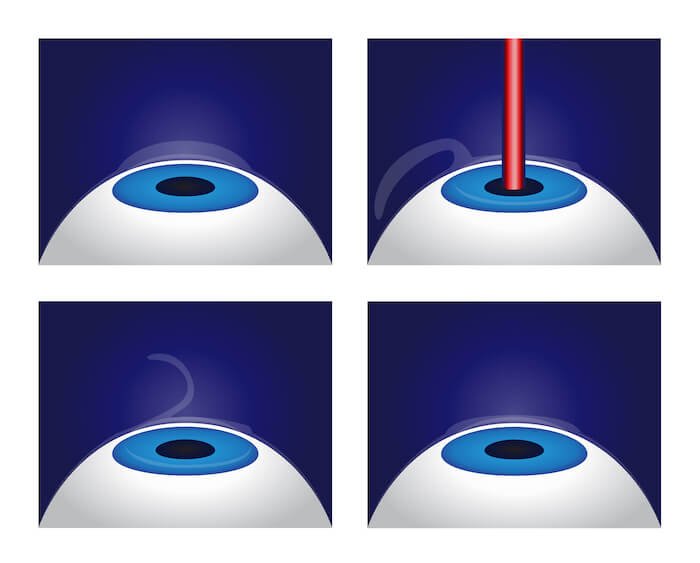
LASIK is an excimer laser surgical procedure that treats the middle layers of the cornea to correct near-sightedness, far-sightedness, and/or astigmatism. LASIK is FDA-approved and is one of the most advanced procedures for correcting focusing problems of the eye. LASIK is performed using numbing drops to prevent pain during the procedure. A vacuum ring secures the eye while a thin layer of the cornea is formed into a flap. This flap is folded over, and the laser surgery is performed on the bed of the cornea that is exposed. The laser treatment reshapes the cornea to treat the refractive condition. The actual laser portion of the procedure lasts 10 to 60 seconds. The flap is then placed back into its original position and observed for 2-3 minutes to ensure that it is fully adherent.
Advantages of LASIK include:
- Little or no discomfort following the surgery
- Recovery of vision often within 1-2 days
- Little or no risk of developing haze following treatment
- Ease of doing additional laser treatment should this be necessary.
Flap Free Laser Vision Correction
ASA/PRK (Advanced Surface Ablation/Photorefractive keratectomy)
ASA is a non-cutting, non-incisional, flap-free, minimally-invasive procedure that reshapes the front surface of the cornea to change its focusing power. Because of the flap-free nature, there are absolutely no flap-related complications possible. Surface cells of the cornea (the epithelium) are gently removed from the central portion of the cornea, without creating a flap, to expose the region of the cornea that is treated with the laser. The actual laser time is similar to that with LASIK. The surface cells require two or more days to heal. A soft contact lens is placed over the eye during this period to serve as a bandage. ASA has been FDA approved for treatment of near-sightedness, far-sightedness and astigmatism with the VISX Star laser and long term safety and efficacy has been well established. ASA has been very useful for eyes that have thin corneas as well as those with corneal dystrophies, corneal irregularities or those who have occupational safety needs. Many of our patients like the concept of flap free surgery and choose this option. Additionally, ASA is now the most commonly used vision-correcting procedure by the United States Army, Navy, Air Force, Marine Corps, and NASA astronauts!
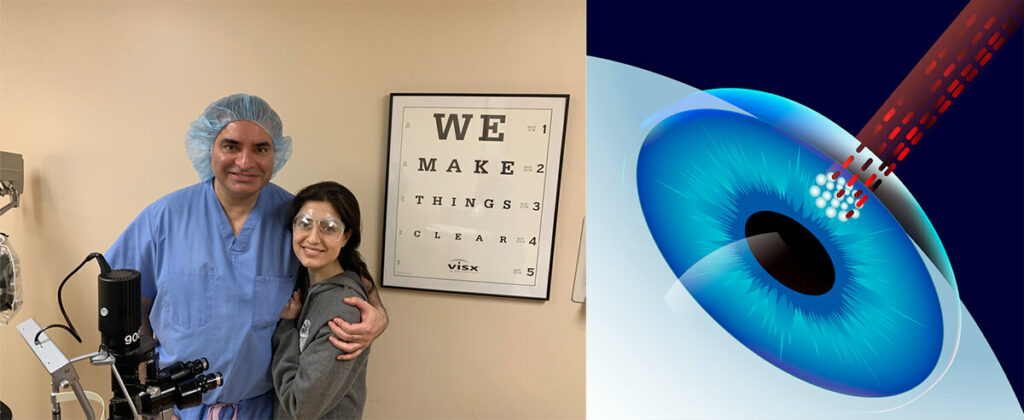
Dr. Husain’s own daughter following the ASA procedure
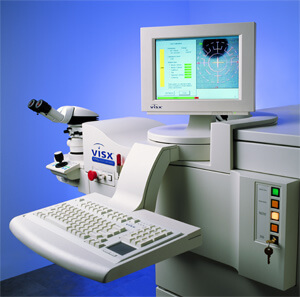
Who is a candidate? Is it right for me?
Risks and Benefits
Benefits
When considering refractive surgery, as with any procedure, the patient and the physician work together to evaluate the relative risks and benefits for each individual patient. The benefits of the procedure are a reduction (and possible elimination) of near-sightedness, far- sightedness and astigmatism. A successful outcome decreases an individual’s dependence on glasses or contact lenses, and in some cases allows one to function without the need for any glasses or contact lenses. This has permitted many patients undergoing the surgery to participate in a variety of activities not previously possible due to their need for glasses (such as water-skiing or scuba diving). When patients discuss their individual experiences following refractive surgery, they frequently describe a general improvement in their overall quality of life as exemplified by such experiences as being able to see the alarm clock in the morning without glasses.
Risks
As with all procedures, refractive surgery is not without risk and side effects. One side effect of the successful correction of myopia is that you will need reading glasses at about age forty-five to see near objects. For nearsighted individuals before surgery, “nearer is clearer”. However, after surgery, if you are older than 40 years of age, you may experience the same difficulty with reading fine print experienced by all “normal” individuals that have never been nearsighted. This may be improved somewhat by intentionally adjusting the treatment of one eye to allow it to remain somewhat nearsighted (blended vision). If you are in this age range, we will discuss this option with you.
Because the surgery involves removal of tissue to change corneal shape, other complications are possible, although they are rare. Infection, if it occurs, can cause corneal scarring and reduce vision, which may not be correctable even with glasses or contact lenses after surgery. Other complications that may occur during or after the surgery include little or no reduction in near-sightedness, inaccurate correction resulting from surgery, scarring of the cornea, healing problems or other unexpected results. Any of these, if they are significant, may require the use of glasses or contact lenses for good vision. In rare instances, as with any surgical procedure on the eye, vision may be permanently reduced as a result of a complication.
Fortunately, the occurrence of significant complications with refractive surgery is very rare. It is important, however, to realize that even though the risks are low, there is no such thing as risk free, guaranteed surgery for any condition.
Cost
The fee for surgery covers the initial evaluation, surgery, postoperative surgical care, enhancement (touch ups), and any follow-up for up to one year related to the procedure. We will discuss surgery fees with you at the initial complimentary screening exam with Dr. Husain. Dr. Husain will perform an extensive eye exam at the preoperative evaluation as well in preparation for your procedure.
The cost for Laser Vision Correction is currently not covered by insurance. The financial advantage of laser refractive surgery is that the high cost of contact lenses, solutions, and spectacles may be reduced, which could result in savings of up to several hundred dollars per year.
How Much Could you Save with LASIK Eye Surgery?
Are you tired of paying for contact lenses, glasses & contact solution? Calculate how much money you can save by choosing LASIK! After completing the calculations, our LASIK coordinator will be in touch to discuss how LASIK can change your life!
Medical saving accounts and FLEX spending accounts have been used for laser vision correction by a large number of our patients. Please ask us for details. It is important to have a screening exam before you decide to use the FLEX/medical saving accounts option.
Zero down payment & zero interest for 18 months financing is available through Wells Fargo Health Advantage. Please ask us for more information regarding financing options.



